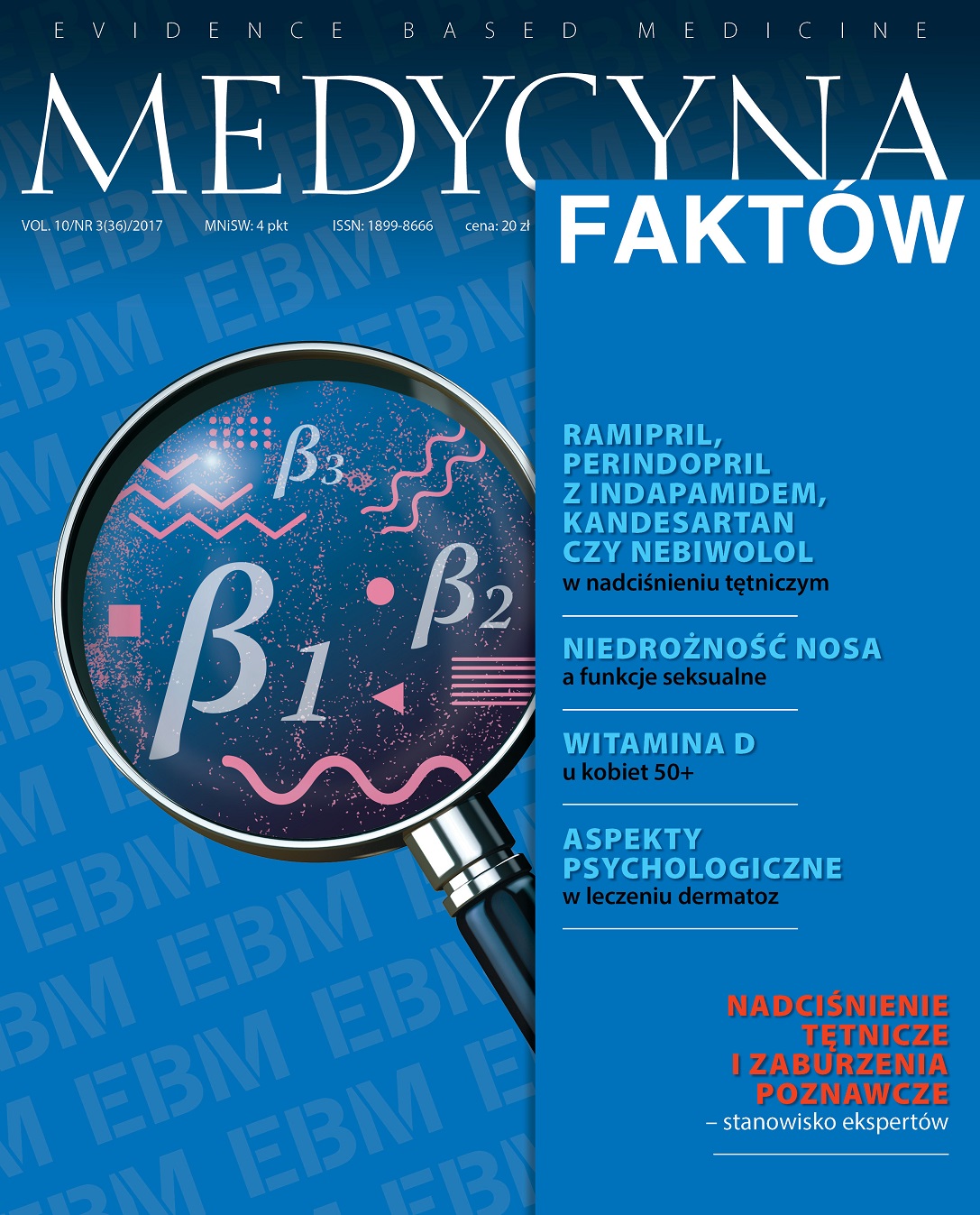Desloratadyna ? współczesny lek przeciwhistaminowy Artykuł przeglądowy
##plugins.themes.bootstrap3.article.main##
Abstrakt
Desloratadyna ze względu na wysoki profil skuteczności i bezpieczeństwa spełnia wymogi współczesnego leku przeciwhistaminowego II generacji stosowanego w chorobach alergicznych. Poprzez powinowactwo do receptora H1 odnajduje szczególne zastosowanie w alergicznym nieżycie nosa i pokrzywce.
##plugins.themes.bootstrap3.article.details##
Jak cytować
Krzych-Fałta, E., & Samoliński , B. (2017). Desloratadyna ? współczesny lek przeciwhistaminowy. Medycyna Faktów , 10(3(36), 258-261. Pobrano z https://journalsmededu.pl/index.php/jebm/article/view/2135
Numer
Dział
Artykuły
Copyright ? by Medical Education. All rights reserved.
Bibliografia
1. Samoliński B.: Raport Epidemiologii Chorób Alergicznych w Polsce. Warszawa 2011.
2. Samoliński B., Raciborski F., Lipiec A. et al.: Epidemiologia Chorób Alergicznych w Polsce. Alergologia Polska 2014; 1: 10-18.
3. Samoliński B., Sybilski A.J., Raciborski F. et al.: Prevalence of rhinitis in Polish population according to the ECAP (Epidemiology of Allergic Discorders in Poland) study. Otolaryngol. Pol. 2009; 63(4): 324-330.
4. Raciborski F., Kłak A., Czarnecka-Operacz M. et al.; EUP WG: Epidemiology of urticaria in Poland ? a nationally-representative survey results. Postępy Dermatologii i Alergologii Polskiej [w druku].
5. Samoliński B., Arcimowicz M.: Polskie Standardy Leczenia Nieżytów Nosa (PoSLeNN). Alergologia Polska 2013; S1.
6. Zuberbier T., Aberer W., Asero R. et al.: The EAACI/GA(2) LEN/EDF/WAO Guideline for the definition, classification, diagnosis, and management of urticaria: the 2013 revision and update. Allergy 2014; 69: 868-887.
7. Zawisza E.: Leki antyhistaminowe III generacji w terapii pyłkowic. Alergia 2002; 2(13).
8. Bil J.: Desloratadyna ? aktualne miejsce terapii alergicznego nieżytu nosa i pokrzywki. Kurier Medyczny, Alergologia 2017.
9. Wikipedia. Desloratadyna [online]; dostęp: 17.07.2017.
10. Weller K., Maurer M.: Desloratadine inhibits human skin mast cell activation and histamine release. J. Invest. Dermatol. 2009; 129: 2723-2726.
11. Charakterystyka Produktu Leczniczego ? desloratadyna.
12. Paśko P., Rodacki T., Domagała-Rodacka R. et al.: Second generation H1 ? antihistamines interaction with food and alcohol ? a systematic review. Biomed. Pharmacother. 2017; 93: 27-39.
13. Sadowska-Woda I., Bieszczad-Bedrejczuk E.: Spektrum działania farmakologicznego desloratadyny. Alergia Astma Immunologia 2010; 15(4): 189-196.
14. Denham K.J., Boutsiouki P., Clough G.F. et al.: Comparison of the effects of desloratadine and levocetirizine on histamine-induced wheal, flare, and itch in human skin. Inflammation. Res. 2003; 52: 424-427.
15. Zheng D., Yang X.:Clinical observation on the therapeutic effect of desloratadine citrate disodium in the treatment of chronic urticarial and changes in IL4, IL18, IL23 and IL-33 levels before and after treatment. Pak. J. Pharm. Sci. 2017; 30(3(Special)): 1139-1142.
16. Brozek J.L., Bousquet J., Baena-Cagnani C.E. et al.: Allergic Rhinitis and its Impact on Asthma (ARIA) guidelines: 2010 revision. J. Allergy Clin. Immunol. 2010; 126(3): 466-476.
2. Samoliński B., Raciborski F., Lipiec A. et al.: Epidemiologia Chorób Alergicznych w Polsce. Alergologia Polska 2014; 1: 10-18.
3. Samoliński B., Sybilski A.J., Raciborski F. et al.: Prevalence of rhinitis in Polish population according to the ECAP (Epidemiology of Allergic Discorders in Poland) study. Otolaryngol. Pol. 2009; 63(4): 324-330.
4. Raciborski F., Kłak A., Czarnecka-Operacz M. et al.; EUP WG: Epidemiology of urticaria in Poland ? a nationally-representative survey results. Postępy Dermatologii i Alergologii Polskiej [w druku].
5. Samoliński B., Arcimowicz M.: Polskie Standardy Leczenia Nieżytów Nosa (PoSLeNN). Alergologia Polska 2013; S1.
6. Zuberbier T., Aberer W., Asero R. et al.: The EAACI/GA(2) LEN/EDF/WAO Guideline for the definition, classification, diagnosis, and management of urticaria: the 2013 revision and update. Allergy 2014; 69: 868-887.
7. Zawisza E.: Leki antyhistaminowe III generacji w terapii pyłkowic. Alergia 2002; 2(13).
8. Bil J.: Desloratadyna ? aktualne miejsce terapii alergicznego nieżytu nosa i pokrzywki. Kurier Medyczny, Alergologia 2017.
9. Wikipedia. Desloratadyna [online]; dostęp: 17.07.2017.
10. Weller K., Maurer M.: Desloratadine inhibits human skin mast cell activation and histamine release. J. Invest. Dermatol. 2009; 129: 2723-2726.
11. Charakterystyka Produktu Leczniczego ? desloratadyna.
12. Paśko P., Rodacki T., Domagała-Rodacka R. et al.: Second generation H1 ? antihistamines interaction with food and alcohol ? a systematic review. Biomed. Pharmacother. 2017; 93: 27-39.
13. Sadowska-Woda I., Bieszczad-Bedrejczuk E.: Spektrum działania farmakologicznego desloratadyny. Alergia Astma Immunologia 2010; 15(4): 189-196.
14. Denham K.J., Boutsiouki P., Clough G.F. et al.: Comparison of the effects of desloratadine and levocetirizine on histamine-induced wheal, flare, and itch in human skin. Inflammation. Res. 2003; 52: 424-427.
15. Zheng D., Yang X.:Clinical observation on the therapeutic effect of desloratadine citrate disodium in the treatment of chronic urticarial and changes in IL4, IL18, IL23 and IL-33 levels before and after treatment. Pak. J. Pharm. Sci. 2017; 30(3(Special)): 1139-1142.
16. Brozek J.L., Bousquet J., Baena-Cagnani C.E. et al.: Allergic Rhinitis and its Impact on Asthma (ARIA) guidelines: 2010 revision. J. Allergy Clin. Immunol. 2010; 126(3): 466-476.
